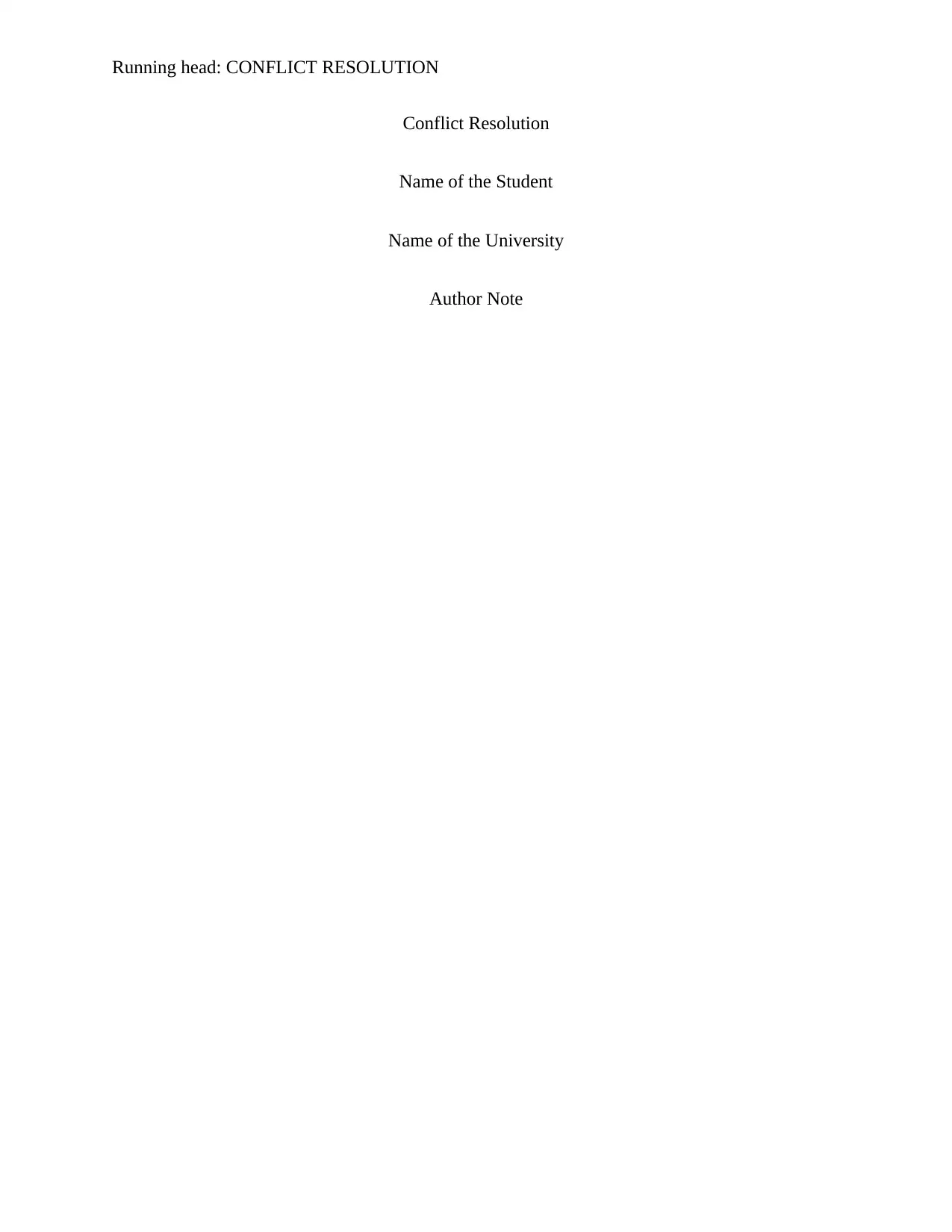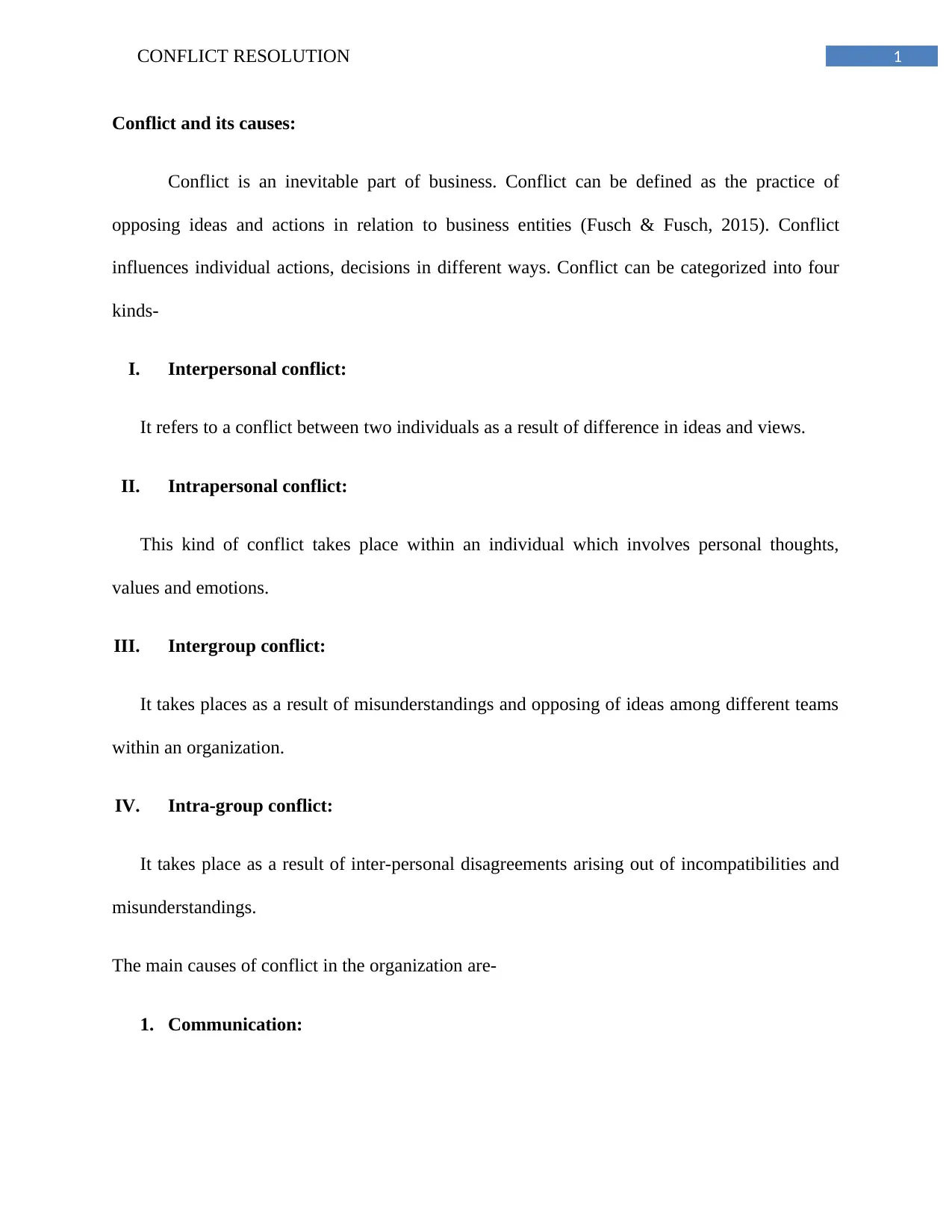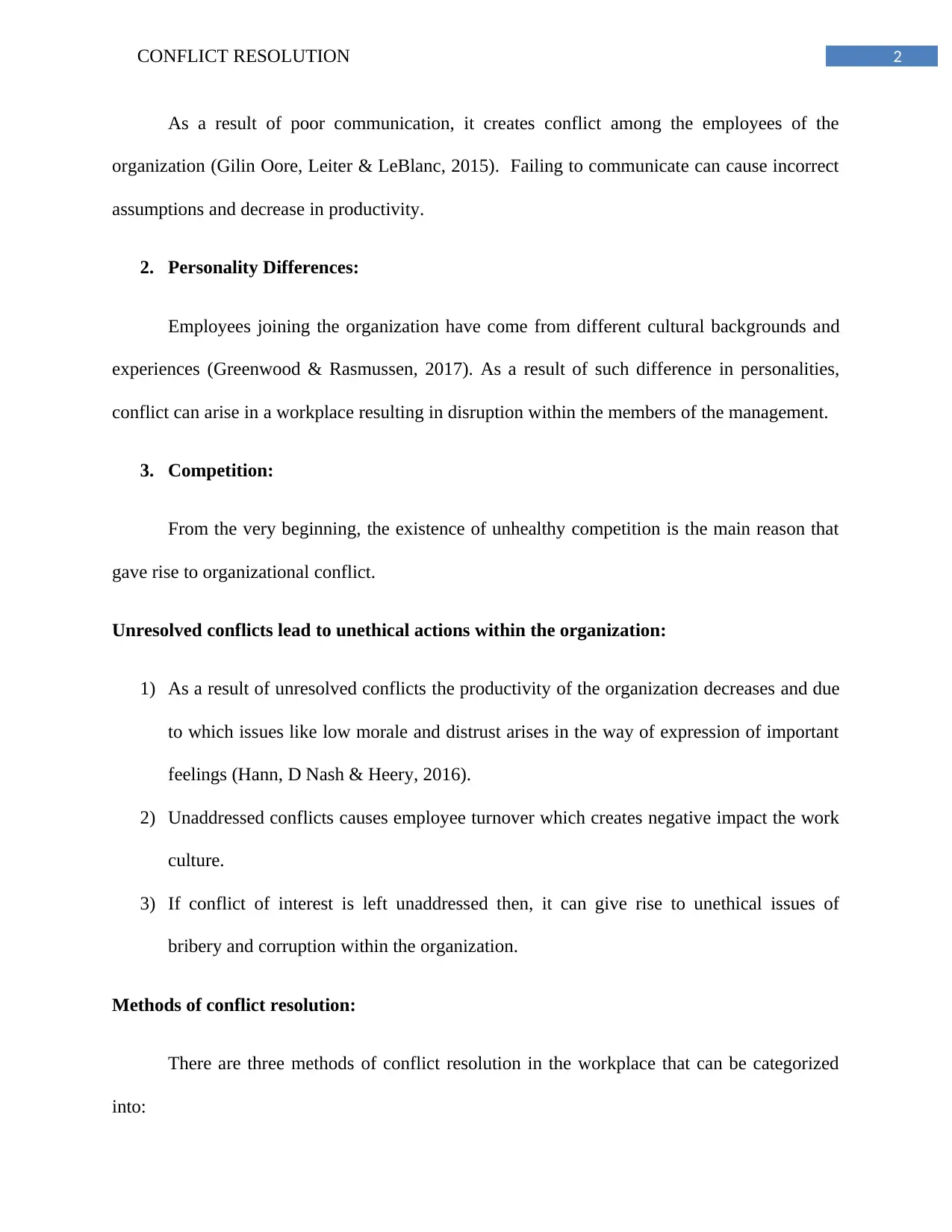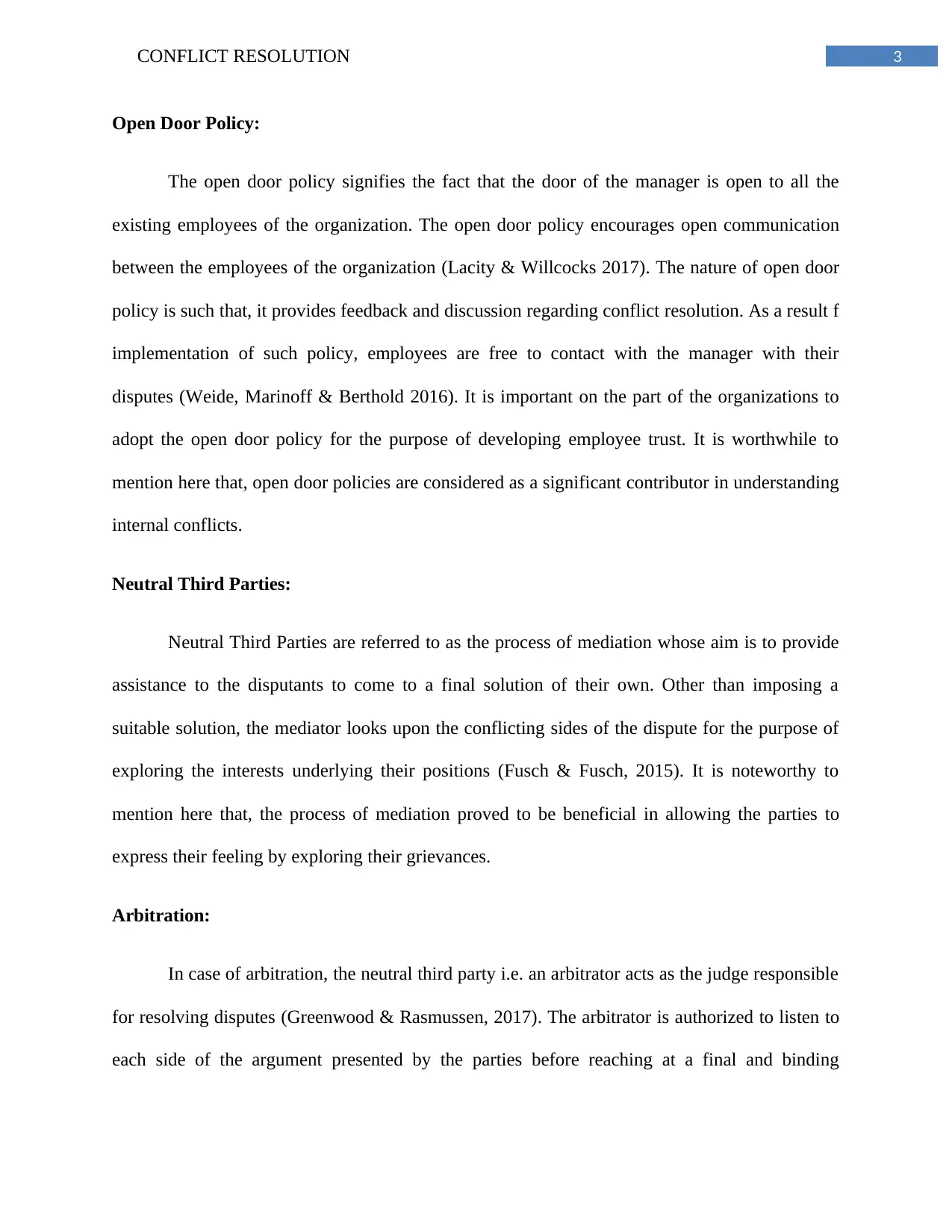Analyzing Workplace Conflict: Causes, Ethical Issues & Resolution Plan
VerifiedAdded on 2023/06/07
|6
|1110
|447
Report
AI Summary
This report provides a comprehensive overview of conflict resolution in the workplace. It begins by defining conflict and exploring its various causes, such as poor communication, personality differences, and unhealthy competition. The report highlights how unresolved conflicts can lead to unethical actions, including decreased productivity, employee turnover, and issues like bribery and corruption. It then delves into basic methods of conflict resolution, including the open-door policy, neutral third-party mediation, and arbitration, detailing how each method works. Finally, the report offers a basic roadmap or plan that employees can follow when encountering conflict within their department, emphasizing the importance of clear communication, problem definition, and follow-up actions. This resource is designed to provide practical guidance for managing and resolving conflicts effectively in a workplace setting.

Running head: CONFLICT RESOLUTION
Conflict Resolution
Name of the Student
Name of the University
Author Note
Conflict Resolution
Name of the Student
Name of the University
Author Note
Paraphrase This Document
Need a fresh take? Get an instant paraphrase of this document with our AI Paraphraser

1CONFLICT RESOLUTION
Conflict and its causes:
Conflict is an inevitable part of business. Conflict can be defined as the practice of
opposing ideas and actions in relation to business entities (Fusch & Fusch, 2015). Conflict
influences individual actions, decisions in different ways. Conflict can be categorized into four
kinds-
I. Interpersonal conflict:
It refers to a conflict between two individuals as a result of difference in ideas and views.
II. Intrapersonal conflict:
This kind of conflict takes place within an individual which involves personal thoughts,
values and emotions.
III. Intergroup conflict:
It takes places as a result of misunderstandings and opposing of ideas among different teams
within an organization.
IV. Intra-group conflict:
It takes place as a result of inter-personal disagreements arising out of incompatibilities and
misunderstandings.
The main causes of conflict in the organization are-
1. Communication:
Conflict and its causes:
Conflict is an inevitable part of business. Conflict can be defined as the practice of
opposing ideas and actions in relation to business entities (Fusch & Fusch, 2015). Conflict
influences individual actions, decisions in different ways. Conflict can be categorized into four
kinds-
I. Interpersonal conflict:
It refers to a conflict between two individuals as a result of difference in ideas and views.
II. Intrapersonal conflict:
This kind of conflict takes place within an individual which involves personal thoughts,
values and emotions.
III. Intergroup conflict:
It takes places as a result of misunderstandings and opposing of ideas among different teams
within an organization.
IV. Intra-group conflict:
It takes place as a result of inter-personal disagreements arising out of incompatibilities and
misunderstandings.
The main causes of conflict in the organization are-
1. Communication:

2CONFLICT RESOLUTION
As a result of poor communication, it creates conflict among the employees of the
organization (Gilin Oore, Leiter & LeBlanc, 2015). Failing to communicate can cause incorrect
assumptions and decrease in productivity.
2. Personality Differences:
Employees joining the organization have come from different cultural backgrounds and
experiences (Greenwood & Rasmussen, 2017). As a result of such difference in personalities,
conflict can arise in a workplace resulting in disruption within the members of the management.
3. Competition:
From the very beginning, the existence of unhealthy competition is the main reason that
gave rise to organizational conflict.
Unresolved conflicts lead to unethical actions within the organization:
1) As a result of unresolved conflicts the productivity of the organization decreases and due
to which issues like low morale and distrust arises in the way of expression of important
feelings (Hann, D Nash & Heery, 2016).
2) Unaddressed conflicts causes employee turnover which creates negative impact the work
culture.
3) If conflict of interest is left unaddressed then, it can give rise to unethical issues of
bribery and corruption within the organization.
Methods of conflict resolution:
There are three methods of conflict resolution in the workplace that can be categorized
into:
As a result of poor communication, it creates conflict among the employees of the
organization (Gilin Oore, Leiter & LeBlanc, 2015). Failing to communicate can cause incorrect
assumptions and decrease in productivity.
2. Personality Differences:
Employees joining the organization have come from different cultural backgrounds and
experiences (Greenwood & Rasmussen, 2017). As a result of such difference in personalities,
conflict can arise in a workplace resulting in disruption within the members of the management.
3. Competition:
From the very beginning, the existence of unhealthy competition is the main reason that
gave rise to organizational conflict.
Unresolved conflicts lead to unethical actions within the organization:
1) As a result of unresolved conflicts the productivity of the organization decreases and due
to which issues like low morale and distrust arises in the way of expression of important
feelings (Hann, D Nash & Heery, 2016).
2) Unaddressed conflicts causes employee turnover which creates negative impact the work
culture.
3) If conflict of interest is left unaddressed then, it can give rise to unethical issues of
bribery and corruption within the organization.
Methods of conflict resolution:
There are three methods of conflict resolution in the workplace that can be categorized
into:
⊘ This is a preview!⊘
Do you want full access?
Subscribe today to unlock all pages.

Trusted by 1+ million students worldwide

3CONFLICT RESOLUTION
Open Door Policy:
The open door policy signifies the fact that the door of the manager is open to all the
existing employees of the organization. The open door policy encourages open communication
between the employees of the organization (Lacity & Willcocks 2017). The nature of open door
policy is such that, it provides feedback and discussion regarding conflict resolution. As a result f
implementation of such policy, employees are free to contact with the manager with their
disputes (Weide, Marinoff & Berthold 2016). It is important on the part of the organizations to
adopt the open door policy for the purpose of developing employee trust. It is worthwhile to
mention here that, open door policies are considered as a significant contributor in understanding
internal conflicts.
Neutral Third Parties:
Neutral Third Parties are referred to as the process of mediation whose aim is to provide
assistance to the disputants to come to a final solution of their own. Other than imposing a
suitable solution, the mediator looks upon the conflicting sides of the dispute for the purpose of
exploring the interests underlying their positions (Fusch & Fusch, 2015). It is noteworthy to
mention here that, the process of mediation proved to be beneficial in allowing the parties to
express their feeling by exploring their grievances.
Arbitration:
In case of arbitration, the neutral third party i.e. an arbitrator acts as the judge responsible
for resolving disputes (Greenwood & Rasmussen, 2017). The arbitrator is authorized to listen to
each side of the argument presented by the parties before reaching at a final and binding
Open Door Policy:
The open door policy signifies the fact that the door of the manager is open to all the
existing employees of the organization. The open door policy encourages open communication
between the employees of the organization (Lacity & Willcocks 2017). The nature of open door
policy is such that, it provides feedback and discussion regarding conflict resolution. As a result f
implementation of such policy, employees are free to contact with the manager with their
disputes (Weide, Marinoff & Berthold 2016). It is important on the part of the organizations to
adopt the open door policy for the purpose of developing employee trust. It is worthwhile to
mention here that, open door policies are considered as a significant contributor in understanding
internal conflicts.
Neutral Third Parties:
Neutral Third Parties are referred to as the process of mediation whose aim is to provide
assistance to the disputants to come to a final solution of their own. Other than imposing a
suitable solution, the mediator looks upon the conflicting sides of the dispute for the purpose of
exploring the interests underlying their positions (Fusch & Fusch, 2015). It is noteworthy to
mention here that, the process of mediation proved to be beneficial in allowing the parties to
express their feeling by exploring their grievances.
Arbitration:
In case of arbitration, the neutral third party i.e. an arbitrator acts as the judge responsible
for resolving disputes (Greenwood & Rasmussen, 2017). The arbitrator is authorized to listen to
each side of the argument presented by the parties before reaching at a final and binding
Paraphrase This Document
Need a fresh take? Get an instant paraphrase of this document with our AI Paraphraser

4CONFLICT RESOLUTION
decision. In this regard, there is an authority on the part of the disputants to negotiate the
disputant aspects in the process of arbitration.
Plan to be followed by an employee when encountering conflict management:
i. Acknowledging a difficult situation is equally important (Lacity & Willcocks, 2017).
Therefore, emphasis must be laid upon honest and clear communication for further
initiation of resolution process.
ii. The problem should be defined to the highest degree possible.
iii. Determination of the actual problem is equally necessary. The ultimate motive of conflict
resolution is to reach at a final solution.
iv. It is important to keep follow up and undertake monitoring actions for the purpose of
determining the action of the parties.
v. If the conflict prevailing in the organization remains unresolved then it is important on
the part of the management to explore new avenues (Hann, Nash & Heery, 2016). In
most of the cases, conflict arises as a result of performance issue.
decision. In this regard, there is an authority on the part of the disputants to negotiate the
disputant aspects in the process of arbitration.
Plan to be followed by an employee when encountering conflict management:
i. Acknowledging a difficult situation is equally important (Lacity & Willcocks, 2017).
Therefore, emphasis must be laid upon honest and clear communication for further
initiation of resolution process.
ii. The problem should be defined to the highest degree possible.
iii. Determination of the actual problem is equally necessary. The ultimate motive of conflict
resolution is to reach at a final solution.
iv. It is important to keep follow up and undertake monitoring actions for the purpose of
determining the action of the parties.
v. If the conflict prevailing in the organization remains unresolved then it is important on
the part of the management to explore new avenues (Hann, Nash & Heery, 2016). In
most of the cases, conflict arises as a result of performance issue.

5CONFLICT RESOLUTION
References:
Fusch, P. I., & Fusch, G. E. (2015). Leadership and conflict resolution on the production
line. International Journal of Applied Management and Technology, 14(1), 7.
Gilin Oore, D., Leiter, M. P., & LeBlanc, D. E. (2015). Individual and organizational factors
promoting successful responses to workplace conflict. Canadian Psychology/psychologie
canadienne, 56(3), 301.
Greenwood Ph D, G., & Rasmussen, E. (2017). Transforming New Zealand Employment
Relations: At the Intersection of Institutional Dispute Resolution and Workplace Conflict
Management.
Hann, D., Nash, D., & Heery, E. (2016). Workplace conflict resolution in Wales: The
unexpected prevalence of alternative dispute resolution. Economic and Industrial
Democracy, 0143831X16663013.
Lacity, M., & Willcocks, L. (2017). Conflict resolution in business services outsourcing
relationships. The Journal of Strategic Information Systems, 26(2), 80-100.
Weide, D., Marinoff, J., & Berthold, T. (2016). 13 Conflict Resolution Skills. Foundations for
Community Health Workers, 345.
References:
Fusch, P. I., & Fusch, G. E. (2015). Leadership and conflict resolution on the production
line. International Journal of Applied Management and Technology, 14(1), 7.
Gilin Oore, D., Leiter, M. P., & LeBlanc, D. E. (2015). Individual and organizational factors
promoting successful responses to workplace conflict. Canadian Psychology/psychologie
canadienne, 56(3), 301.
Greenwood Ph D, G., & Rasmussen, E. (2017). Transforming New Zealand Employment
Relations: At the Intersection of Institutional Dispute Resolution and Workplace Conflict
Management.
Hann, D., Nash, D., & Heery, E. (2016). Workplace conflict resolution in Wales: The
unexpected prevalence of alternative dispute resolution. Economic and Industrial
Democracy, 0143831X16663013.
Lacity, M., & Willcocks, L. (2017). Conflict resolution in business services outsourcing
relationships. The Journal of Strategic Information Systems, 26(2), 80-100.
Weide, D., Marinoff, J., & Berthold, T. (2016). 13 Conflict Resolution Skills. Foundations for
Community Health Workers, 345.
⊘ This is a preview!⊘
Do you want full access?
Subscribe today to unlock all pages.

Trusted by 1+ million students worldwide
1 out of 6
Related Documents
Your All-in-One AI-Powered Toolkit for Academic Success.
+13062052269
info@desklib.com
Available 24*7 on WhatsApp / Email
![[object Object]](/_next/static/media/star-bottom.7253800d.svg)
Unlock your academic potential
Copyright © 2020–2025 A2Z Services. All Rights Reserved. Developed and managed by ZUCOL.




